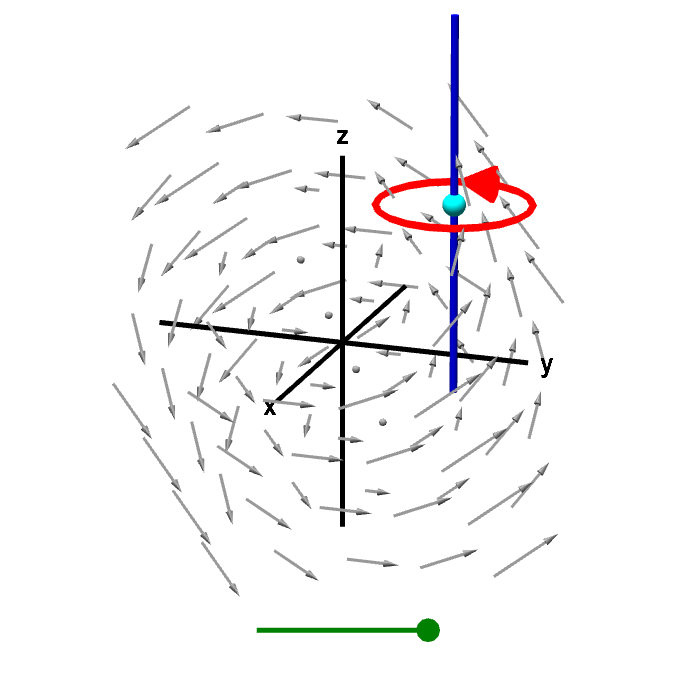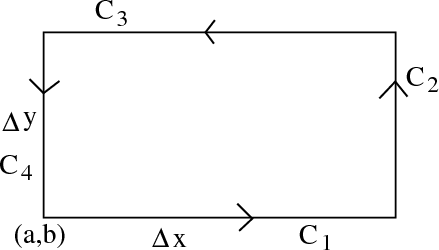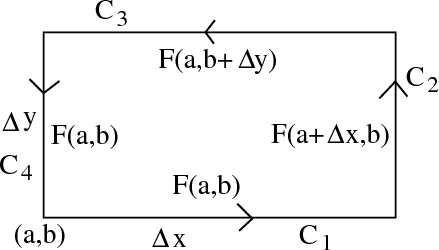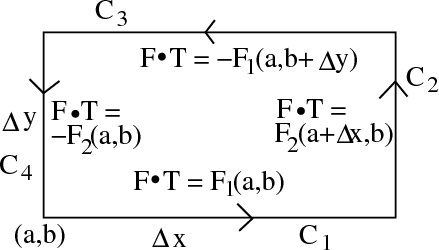Math Insight
Calculating the formula for circulation per unit area
Given the definition for a component of the curl in the direction of a unit vector, we can sketch a proof for the formula of the “microscopic circulation” that we identify with curl. For simplicitiy, we will focus on the z
-component of the curl, curlF⋅k
, which is defined as
curlF(a)⋅k=lim A(C)→0 1A(C) ∫ C F⋅ds,
for a curve C
around the point a=(a,b,c)
in a plane that is parallel to the xy
-plane. In the above limit, we let C
shrink to a point so that the area A(C)
inside C
reduces to zero, as illustrated in the below applet. Since we divided by the area A(C)
, we can interpret curl as being a “circulation per unit area.”
 A line integral gives z-component of curl. A line integral around a curve in a plane perpendicular to the
A line integral gives z-component of curl. A line integral around a curve in a plane perpendicular to the z
-axis gives circulation of the vector field corresponding to the z
-component of the curl. Dividing this line integral the the area of the region inside the curve, and letting the curve shrink to zero gives circulation per unit area. This circulation per unit area is the z
-component of the curl. You can drag the red point on the slider to shrink the curve to a point.
More information about applet. The curve C
is contained in the plane parallel to the xy
-plane that passes through a
, i..e., the plane given by z=c
. In the integral, we can eliminate z
by replacing it with the constant value c
. Moreover, the tangent vectors along C
must be parallel to the xy
plane, which means their z
-components will be zero. Since the line integral of a vector field integrates the tangent components of the vector field, the z
-component of F
will drop out of the integral ∫ C F⋅ds
. Hence, we can, without loss of generality, replace our three-dimensional vector field F(x,y,z)
with a two-dimensional vector field F(x,y)
consisting of the first two components of the original F
evaluated at z=c
. We can then view the curve C
as lying in the xy
-plane.
Besides simplifying the notation, this change of perspective make explicit the fact that this calculation is also valid for calculating the “microscopic circulation” of two-dimensional vector fields, like we need for Green's theorem. We just need to remember that, by the right hand rule, positive values of the circulation correspond to counterclockwise rotation in thexy
-plane.
The introductory pages give some intuition why the “circulation per unit area” of thez
-component of the curl is
curlF⋅k=∂F 2 ∂x −∂F 1 ∂y .
Here we sketch a proof why
1A(C) ∫ C F⋅ds→∂F 2 ∂x −∂F 1 ∂y
as we let C
shrink to a point. Rather than use the circular C
illustrated in the above applet, we let C
be a rectangular curve, oriented counterclockwise. For simplicity of the notation, we'll let (a,b)
be the lower-left point of C
rather than being in the middle. Let the width and height of C
be Δx
and Δy
, respectively. Label the edges of the rectangle by C 1
, C 2
, C 3
, and C 4
.
We assume the rectangle is small enough to approximateF
as constant along each edge. Along the curve C 1
, the value of y
is constantly b
, but the value of x
changes from a
to a+Δx
. We assume we can ignore that change in x
(since the rectangle is small), and simply approximate F(x,y)
as F(a,b)
all along the segment C 1
.
Along the curveC 2
, the value of x
is constantly a+Δx
, but y
changes from b
to b+Δy
. Since we assume we can ignore the change in y
, we approximate F(x,y)
as F(a+Δx,b)
all along segment C 2
.
Similiarly, we approximateF(x,y)
as F(a,b+Δy)
all along segment C 3
and approximate F(x,y)
as F(a,b)
all along segment C 4
. We summarize these approximations in the following figure.
Next, to compute the integral∫ C F⋅ds
, we remember that it is the same thing as integrating the scalar-valued function F⋅T
, where T
is the unit tangent vector along C
:
∫ C F⋅ds=∫ C F⋅Tds.
We need to computeF⋅T
along each segment of C
. The tangent vector T
is constant along each segment, and we are approximating F
as constant along each segment, so the dot product F⋅T
will be constant along each segment of C
.
AlongC 1
, the path is directed in the positive x
direction, so the unit tangent vector is T=(1,0)
. The dot product F⋅T
is simply the first component of F(a,b)
:
F⋅T=F 1 (a,b).
AlongC 2
, the path is directed in the positive y
direction, so T=(0,1)
, and F⋅T
is simply the second component of F(a+Δx,b)
:
F⋅T=F 2 (a+Δx,b).
AlongC 3
, the path is directed in the negative x
direction, so the unit tangent vector is T=(−1,0)
. The dot product F⋅T
is minus the first component of F(a,b+Δy)
:
F⋅T=−F 1 (a,b+Δy).
AlongC 4
, the path is directed in the negative y
direction, so T=(0,−1)
, and F⋅T
is minus the second component of F(a,b)
:
F⋅T=−F 2 (a,b).
We summarize these findings in the following figure.
The integrals are now easy to compute. AlongC 1
, F⋅T
is constant, so the integral is simply its value F 1 (a,b)
times the length of the segment Δx
:
∫ C 1 F⋅ds=∫ C 1 F⋅Tds=∫ C 1 F 1 (a,b)ds=F 1 (a,b)Δx.
Along C 2
, the integral is F 2 (a+Δx,b)
times its length Δy
:
∫ C 2 F⋅ds=F 2 (a+Δx,b)Δy.
Similarly,
∫ C 3 F⋅ds=−F 1 (a,b+Δy)Δx,
and
∫ C 4 F⋅ds=−F 2 (a,b)Δy.
The integral around all ofC
is just the sum along the four segments
∫ C F⋅ds =∫ C 1 F⋅ds+∫ C 2 F⋅ds+∫ C 3 F⋅ds+∫ C 4 F⋅ds=F 1 (a,b)Δx+F 2 (a+Δx,b)Δy−F 1 (a,b+Δy)Δx−F 2 (a,b)Δy.
The circulation per unit area is the integral divided by the area of the rectangle, which isΔxΔy
∫ C F⋅dsΔxΔy =F 2 (a+Δx,b)Δy−F 2 (a,b)Δy−(F 1 (a,b+Δy)Δx−F 1 (a,b)Δx)ΔxΔy .
Half of the numerator is multiplied byΔy
and half is multiplied byΔx
. If we separate these into two fractions, we can cancel the Δy
in the first fraction with the Δy
in the demoninator
F 2 (a+Δx,b)Δy−F 2 (a,b)ΔyΔxΔy =F 2 (a+Δx,b)−F 2 (a,b)Δx .
In the second fraction, we can cancel theΔx
,
F 1 (a,b+Δy)Δx−F 1 (a,b)ΔxΔxΔy =F 1 (a,b+Δy)−F 1 (a,b)Δy .
Putting these back together, we have
∫ C F⋅dsΔxΔy =F 2 (a+Δx,b)−F 2 (a,b)Δx −F 1 (a,b+Δy)−F 1 (a,b)Δy .
Now, we let the curveC
shrink down to a point. This means that Δx→0
and Δy→0
. In this limit, the two fractions become something familar: partial derivatives of F
.
lim Δx,Δy→0 ∫ C F⋅dsΔxΔy =lim Δx→0 F 2 (a+Δx,b)−F 2 (a,b)Δx −lim Δy→0 F 1 (a,b+Δy)−F 1 (a,b)Δy =∂F 2 ∂x (a,b)−∂F 1 ∂y (a,b).
Therefore, the circulation per unit area around the point(x,y)=(a,b)
is
∂F 2 ∂x (a,b)−∂F 1 ∂y (a,b).
This is the expression for the scalar curl that we use for the “microscopic circulation” in Green's theorem. If we rewrite this in terms of the original three-dimensional vector field F(x,y,z)
at the point (x,y,z)=(a,b,c)
, we obtain the expression for the z
-component of the curl
curlF(a,b,c)⋅k=∂F 2 ∂x (a,b,c)−∂F 1 ∂y (a,b,c)
as promised.

More information about applet.
Besides simplifying the notation, this change of perspective make explicit the fact that this calculation is also valid for calculating the “microscopic circulation” of two-dimensional vector fields, like we need for Green's theorem. We just need to remember that, by the right hand rule, positive values of the circulation correspond to counterclockwise rotation in the
The introductory pages give some intuition why the “circulation per unit area” of the
We assume the rectangle is small enough to approximate
Along the curve
Similiarly, we approximate
Next, to compute the integral
We need to compute
Along
Along
Along
Along
We summarize these findings in the following figure.
The integrals are now easy to compute. Along
The integral around all of
The circulation per unit area is the integral divided by the area of the rectangle, which is
Half of the numerator is multiplied by
In the second fraction, we can cancel the
Now, we let the curve
Therefore, the circulation per unit area around the point
Thread navigation
Math 2374
Multivariable calculus
Notation systems
More information on notation systemsSimilar pages
- The idea behind Green's theorem
- The definition of curl from line integrals
- The idea behind Stokes' theorem
- The components of the curl
- A path-dependent vector field with zero curl
- Stokes' theorem examples
- Subtleties about curl
- Green's theorem with multiple boundary components
- Introduction to a line integral of a vector field
- The integrals of multivariable calculus
- More similar pages



No comments:
Post a Comment